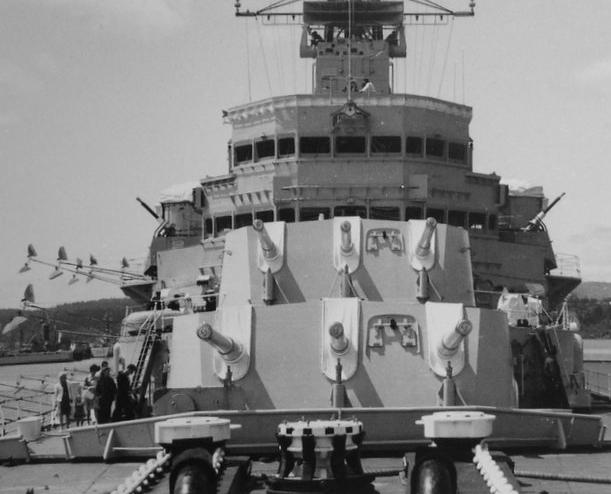The six ship Melbourne class was instigated by the Australis navy wanting to make sure they had cruisers that could take on the Japanese Mogami class ships. Originally the design was to have four quadruple 6" turrets in comparison to the 5x3 6" on the Mogami and US Brooklynn class. Both those classes featured a turret that was really only available for broadside firing. The quadruple turret proved too complex and would have required more breadth of ship to be viable, the design was recast to mount five triple 6". The first three units completed in 1939 and the second trio in 1940.

The Melbourne class utilised a lot of the parts and superstructure from the Exeter type but the 15x6" required quite a different layout internally compared to the 9x8" of the Exeter. The Melbourne type differed from the Japanese and US versions as they had the three turrets aft (XYZ) while the US and Japanese had them mounted forward (ABC). The C turret on the US ships and B turret on the Japanese ships were in awkward positions and were only really useful for broadside firing. All the guns of the Commonwealth cruisers could fire aft, not that they expected to be chased very often.

As the Fairey Swordfish was replaced in service by the SeaBattle, some of the obsolete Swordfish were converted to floatplanes to suit the cruisers and battleships.
It was a Swordfish off the Dundee that spotted the German cruiser Karlsberg (9x5.9") trying to sneak along the Norwegian coast, in May 1940, to get to Narvik where it was supposed to provide heavy support for the destroyers there. The Karlsberg would never make it. Acting on the Swordfishes reports, the Dundee took up an interception course and the chase was on. The Kapitan of the Karlsberg knew the only way to shake off the Dundee (any ship with a spotter plane was liable to be as big if not bigger than his ship) was to get rid of the Swordfish spotting for the Dundee. The Karlsberg launched its Heinkel He-60 floatplane and what followed was a return to the air battles of World War One as the two bi-planes circled each other trying to get an advantage. Both had a machine gun in a rear cockpit mounted on a flexible arm that allowed the gun to fire on both sides of the aircraft. The German pilot was under instructions that if he could not shoot down the Swordfish he should ram it. After ten minutes of stalemate, with both aircraft firing at each other, but neither hitting anything important, the order came from the Karlsberg - Ram! The aerial circus carried on as the pilot of the Swordfish divined what the German intentions were and was still transmitting to the Dundee, when the Dundee advised that they had the Karlsberg on Radar and that they could return for pick-up. The Swordfish dived for the safety of the wave tops and evaded the He-60, scuttling across the waves heading back on its homing signal. The He-60 was not recalled but ordered to follow and seek out what was the home base of the Swordfish. A few minutes later the answer steamed into view. The Swordfish had seen what was happening and soared, giving the rear gunner a chance to shoot at the Heinkel. By a lucky coincidence (of course) the gunfire hit the radio/air gunner making the He-60 unable to fire back or communicate with its ship. Having seen the size of the cruiser running down on his ship, the German Pilot went, not back to his ship, but for the Norwegian coast where he might get lucky to land somewhere where there was a German Military presence. He wanted to survive.
The Karlsberg was now blind in comparison to the Dundee. The Dundee had the Karlsberg on its radar plot and was waiting for the range to come down. Conditions were perfect, calm sea, visibility forever, the Captain aboard the Dundee just knew it was going to be his day. Both ships could see each other with the Dundee coming in on an angle and heading the Karlsberg. At 25,000 yards the Karlsberg opened fire, with the Dundee returning fire just seconds later. Both ships were shooting well but the Dundee's advantage in firepower soon became obvious, fifteen guns to nine made all the difference. Karlsberg took a lot of damage that it could not handle. Built to the early 6,000 ton limit the Germans had for cruisers meant that its armour was more of a gesture over the vitals. Multiple hits on the forebridge and turret knocked out a third of the armament and the command structure, Karlsberg Kapitan was dead as was most of the senior officers. The ships Kapitan-leutnant was commanding the ship from the after conning position. He was trying to get the Karlsberg into position to fire torpedoes at the Dundee, to force the Dundee to turn away. The Dundee made sure to keep slightly ahead of the Karlsberg and keep the firing solution for torpedoes off the table. Three more salvoes from the Dundee and the Karlsberg was a wreck with just one 88mm twin mounting still firing. The Dundee came in and fired a bank of torpedoes at the Karlsberg, two hitting and ending the career of that fine ship.
That was the highlight of the Dundees career, as the ship was tied to the Home Fleet for all its war, acting as part of the escort for the Capital Ships. Only other bit of excitement for the ship was acting as escort to the Duke of York when that ship crippled the Scharnhorst and allowed it to be sunk by the escorting destroyers torpedoes.
